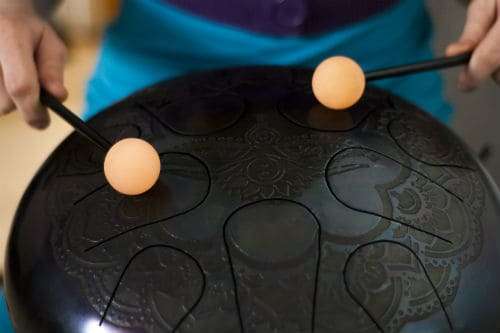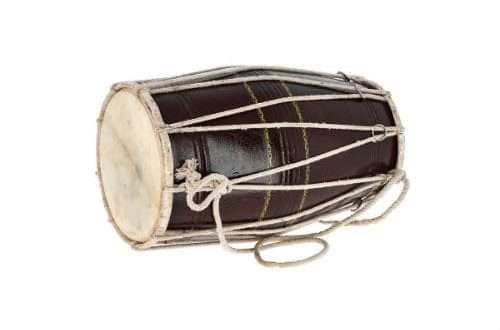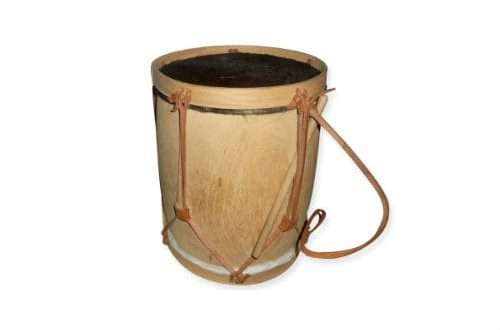
Glucophone: instrument description, sound, history, types, how to play, how to choose
Contents
There are a huge number of musical instruments in the world: piano, harp, flute. Most people don’t even know they exist. A prime example of this is the glucophone.
What is a Glucophone
Glucophone (in English tank / hapi / steel tongue drum) – petal drum, widely used as an accompaniment to meditation, yoga. It relieves any stress, immerses you in a state of rest, charges you with vital energy, and develops the ability to improvise.

Unearthly sounds tune the mind to the waves of harmony, help put thoughts in order, dispel doubts. Melodies develop the right hemisphere of the brain: a creative person needs it.
How does a glucophone work?
Its main elements are 2 bowls. On one are the petals (tongues) of the composition, on the other – a resonating hole. A clear feature of the reeds is that each is tuned to a specific note, the number of petals is equal to the number of notes. The tonality of music is determined by the size of the reed – with an increase in the impact surface, the sound of the tone decreases.
Thanks to the special production technology of the instrument, the melody comes out as a single, pure, harmonious melody.
Various modifications are possible: changing the geometry of the petals, the volume of the body, the wall thickness.
What does a glucophone sound like?
The music vaguely resembles the ringing of bells, the sounds of a xylophone and is associated with space. The melody envelops the listener, he plunges into it with his head. Relaxation, a sense of peace come literally from the first notes.
How is it different from hanga and fimbo
There are a couple of tools similar to the hero of the article:
- Hang appeared seven years before hapi drum’a. Hang consists of 2 parts fastened together, similar to an inverted plate. It has no noticeable cuts on the top bowl, only round holes. It sounds louder, richer, vaguely similar to metal drums.
- Fimbo is called an analogue of a glucophone in terms of sound and appearance. Both have slits on the top. The difference lies in the form. The first one looks like two cymbals soldered along the edges, reminiscent of a hang with cuts instead of dents, like a steel tongue drum. Another difference is the price. Fimbo costs one and a half to three times cheaper than a “relative”.

The history of the creation of the glucophone
Slotted drums, prototypes of metal drums, were invented thousands of years ago. They are the oldest musical instruments of African, Asian, South American cultures. For their manufacture, they took a part of a tree trunk, cut rectangular holes in it – slots, from which the name came.
The first modern tank can appeared around 2007. Spanish percussionist Felle Vega invented a new leaf drum called the “Tambiro”. The musician took an ordinary propane tank, which serves him instead of Tibetan singing bowls, and made cuts. The invention quickly gained popularity. They began to make it from high-quality materials, changed the shape.
The famous instrument maker Denis Khavlena improved the composition, came up with the idea of placing tongues on its bottom. This turned out to be more convenient to work with and allowed ten notes to be placed.
Varieties of the glucophone
Depending on a number of parameters, there are different models.

To size
- small (about 20 cm in cross section);
- medium (30 cm);
- large (40 cm);
Tank drum can weigh 1,5-6 kilograms.
According to the form
- spherical;
- elliptical;
- discoid;
- in the form of a parallelepiped.
By tongue type
- slanting;
- straight;
- round;
- square;
- rectangular.
By number of sheets
- 4-leaf;
- 12-leaf.
By type of coverage
- brass-plated;
- painted (lacquer is considered an absorber of part of the vibrations, which is bad for drums);
- blued (the material is coated with a layer of iron oxide and it acquires golden brown hues);
- burnt with oils.
By structure
- with the ability to change intonations (thanks to the percussion elements bent up);
- one-sided (sheets are located on the front side opposite the technical hole, one adjustment is available);
- bilateral (ability to make 2 settings);
- with effect pedals.
Play technique
To play the tone drum, you do not need to have an ear for music, an ideal sense of rhythm – the necessary skill will appear by itself. All you need is fingers or rubber sticks.
When playing with hands, pads and knuckles from the inner part of the palm are used. Sounds are of moderate volume. A palm strike produces a muffled, noisy sound. It is better to try sticks made of rubber or felt – with them the melody becomes clearer, louder.
The rules common to all ways of playing are that you should hit sharply, but not strongly, “bounce” off the surface. A long, rich sound is produced exclusively by short strokes.

How to choose a glucophone
The best advice is not to settle for the first option that comes across.
First of all consider the size. Large ones have a deep, voluminous sound, compact ones – sonorous, high. Tank drums with a diameter of 22 cm are single-sided, medium and large are double-sided.
The second step is choosing a setting. The best solution is to listen to the possible sound options, then select your favorite. With a more conscious approach, they take into account the harmony – major or minor, there are meditative, mystical (with shades of mystery) motives.
The most suitable type for beginners is pentatonic. In the usual scale there are 2 notes that complicate the Play: if handled incorrectly, disharmony appears. In the modified version, they are not, as a result of which any music sounds beautiful.
The last step is choosing a design. It is enough to highlight the design that you like more than the rest. There are different types of cases, the most popular being engraved. But now young people are more likely to buy simple monochrome models in a matte or glossy finish. The audience especially liked the black, iridescent colors.
The petal drum is an extraordinary musical instrument, but at the same time easy to use. It will be an excellent choice for beginners and lovers of relaxing, happy music.





